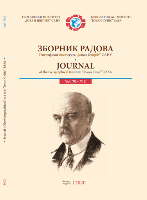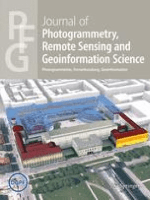
Geographia Technica
metrics 2024
Innovating Research at the Crossroads of Geography and Technology
Introduction
Geographia Technica is an esteemed academic journal published by GEOGRAPHIA TECHNICA ASSOCIATION - GT Assoc in Romania, serving as a vital platform for the dissemination of cutting-edge research in the interdisciplinary fields of geography, planning, and earth sciences. Since its inception in 2009 and continuing through to 2024, the journal has established itself as a respected source of knowledge, reflected in its classification within the Q3 category across significant fields such as Computers in Earth Sciences, Earth-Surface Processes, and Geography, Planning and Development. With the ambition to enhance the understanding of socio-environmental interactions and technological applications in these areas, Geographia Technica invites scholars and practitioners to contribute original research that pushes the boundaries of current knowledge. Although currently not listed as open access, the journal's engaging content ensures it remains a valuable resource for researchers, professionals, and students keen on advancing their expertise in these dynamic disciplines.
Metrics 2024
 0.25
0.25 0.70
0.70 0.60
0.60 16
16Metrics History
Rank 2024
Scopus
IF (Web Of Science)
JCI (Web Of Science)
Quartile History
Similar Journals

Cuadernos de Investigacion Geografica
Bridging Disciplines in Geography and Environmental AnalysisCuadernos de Investigacion Geografica, published by UNIV RIOJA, SERV PUBLICACIONES, stands as a premier open-access journal dedicated to advancing knowledge in the fields of geography, environmental science, and earth sciences. Since its inception in 1983, this journal has fostered innovative research and critical discourse, currently holding a distinguished position in Scopus with impressive quartile rankings, including Q2 in both Earth and Planetary Sciences, and Geography, Planning and Development, reflecting its impact and relevance. With an aim to present high-quality, peer-reviewed articles that contribute to the understanding of our planet and its systems, Cuadernos de Investigacion Geografica welcomes submissions from researchers, professionals, and students alike, fostering a collaborative environment that spans across diverse geographical contexts. Operating from its hub in Logroño, Spain, this journal continues to be a vital resource for anyone engaged in geographical research and environmental analysis, providing open access to enhance knowledge sharing and innovation in these dynamic fields.

Geoenvironmental Disasters
Transforming research into actionable disaster management.Geoenvironmental Disasters, published by SPRINGERNATURE, is a leading open-access journal dedicated to advancing the interdisciplinary fields of environmental science, geography, and geotechnical engineering. Since its inception in 2014, the journal has made significant strides in disseminating high-quality research that addresses the challenges posed by geoenvironmental hazards and their impacts on society. With an impressive Q1 ranking across multiple categories, including Environmental Science (miscellaneous) and Geography, Planning and Development, it occupies a vital niche within the academic community. The journal’s rigorous peer-review process ensures that only the most insightful contributions are made available to a global audience. Researchers, professionals, and students are encouraged to engage with the content, which covers a wide range of topics, including disaster management, risk assessment, and stakeholder engagement in policy-making. This commitment to open-access accessibility since 2014 further enhances its reach and impact, providing a critical platform for advancing knowledge and innovation in managing geoenvironmental disasters.

Journal of the Geographical Institute Jovan Cvijic SASA
Connecting global research with local impact.The Journal of the Geographical Institute Jovan Cvijic SASA is a premier academic publication dedicated to advancing research and knowledge in diverse fields such as Demography, Earth-Surface Processes, Geography, Geology, and Tourism. Published by the Geographical Institute Jovan Cvijic SASA in Serbia, this Open Access journal has made significant contributions to the academic community since its inception in 1951, allowing for unrestricted dissemination of research findings globally. With an impact factor reflected in its 2023 Q3 quartile rankings across several categories, the journal underlines its relevance by maintaining a significant standing in the Social Sciences and Earth and Planetary Sciences domains, demonstrating engagement at a global level evidenced by its Scopus rankings. The journal's commitment to publishing high-quality, peer-reviewed articles makes it an essential resource for researchers, professionals, and students seeking to explore and enhance their understanding of geographical and environmental dynamics.

Quaestiones Geographicae
Advancing Earth Sciences Through Open DialogueQuaestiones Geographicae, an esteemed open-access journal published by SCIENDO, serves as a vital platform for scholarly communication in the field of Earth and Planetary Sciences. Since its inception in 1979, the journal has been dedicated to promoting rigorous research and discourse in geography, encompassing a breadth of topics that reflect the dynamic nature of the discipline. With an impressive Impact Factor belonging to the Q3 quartile category, the journal actively contributes to the global scientific community's understanding of geographical phenomena. Its commitment to open-access publishing since 2010 ensures that groundbreaking research is accessible to a wider audience, facilitating collaboration and innovation. As part of its enduring legacy, Quaestiones Geographicae engages researchers, professionals, and students alike, inviting them to explore, share, and expand the boundaries of geographical knowledge.

Journal of Geography-Chigaku Zasshi
Fostering Global Dialogue through Geographic InquiryJournal of Geography - Chigaku Zasshi is a distinguished publication that serves as a crucial platform for the dissemination of research in the realm of geography and earth sciences. Published by the TOKYO GEOGRAPHICAL SOC in Japan, this journal is indexed with an ISSN of 0022-135X and an E-ISSN of 1884-0884. With a scope that includes Earth-Surface Processes, Geography, Planning and Development, Geology, Geophysics, and Global and Planetary Change, it provides comprehensive coverage of pressing geographical issues. Although it holds a Q4 ranking in multiple categories as of 2023, the journal presents an opportunity for researchers, professionals, and students to contribute meaningful findings in a diverse and competitive landscape. The Journal of Geography actively promotes scholarly dialogue by embracing the complexities of our planet and encouraging innovative approaches to geographical inquiries. This open-access journal aspires to bridge gaps and foster collaboration among scholars worldwide, underscoring its importance in understanding and addressing contemporary geographic challenges.

Boletin Goiano de Geografia
Navigating the Intersection of Geography and SocietyBoletin Goiano de Geografia is a distinguished academic journal dedicated to the field of Geography, published by the Universidade Federal de Goiás, Instituto de Estudos Socio-Ambientais. Since its inception in 1981, this Open Access journal has provided invaluable insights into the geographical dynamics of Brazil and beyond, promoting scholarly research and dialogue among geographers, environmentalists, and social scientists. The journal seeks to advance knowledge through the dissemination of research articles, reviews, and case studies that address contemporary issues in human and physical geography. With a commitment to fostering interdisciplinary collaboration, Boletin Goiano de Geografia serves as a vital resource for researchers, professionals, and students seeking to explore the complex interactions between society and the environment. Situated in the vibrant academic landscape of Goiana, Brazil, this journal enhances the global discourse on geographical studies and sustainability.

Boletin Geografico
Bridging Disciplines Through Geographical InsightsBoletin Geografico is a distinguished open-access journal published by the Universidad Nacional del Comahue, Department of Geography, promoting the dissemination of high-quality research in the field of geography. Since its inception in 1992, this journal has aimed to foster an interdisciplinary dialogue among scholars, practitioners, and students, providing insights into diverse geographical phenomena and their socio-environmental contexts. With its ISSN 0326-1735 and E-ISSN 2313-903X, the journal offers a rich repository of knowledge, accessible to a global audience, thereby enhancing visibility and impact. By promoting rigorous scientific inquiry and empirical analysis, Boletin Geografico serves as a vital platform for contributing to innovative geographical scholarship and engaging with contemporary issues, making it an essential resource for those invested in understanding the dynamic interplay of human and physical geography.

GeoMedia
Navigating the Dynamic Landscape of Geography and MediaGeoMedia, with ISSN 1128-8132, is a prominent peer-reviewed journal published by MEDIAGEO SCIENCE & TECHNOLOGY PUBLISHING, specializing in the interdisciplinary field of geographical information and media studies. Since its inception in 2005, the journal has embraced an Open Access model, ensuring that cutting-edge research remains accessible to a global audience. Based in Rome, Italy, GeoMedia aims to bridge the gap between geographic data and its applications in media, technology, and societal contexts, fostering innovative research that impacts both academia and industry. With a commitment to contributing to the advancement of knowledge, it encourages submissions that explore theoretical frameworks, case studies, and empirical investigations showcasing the multifaceted relationship between geography and media. GeoMedia stands as a vital resource for researchers, professionals, and students who are keen on exploring the dynamic interplay between geographical phenomena and media technologies.

Revista de Teledeteccion
Pioneering insights in remote sensing innovation.Revista de Teledeteccion, published by UNIV POLITECNICA VALENCIA, EDITORIAL UPV, is a leading Open Access journal dedicated to the interdisciplinary field of remote sensing and its applications. Since its inception in 2010, this journal has provided a vital platform for researchers, professionals, and students to disseminate groundbreaking findings, foster collaboration, and engage with contemporary challenges in Earth and Planetary Sciences as well as Geography, Planning, and Development. With a Q3 ranking in both fields as of 2023, it serves as an essential resource for advancing knowledge and innovative practices in hi-tech remote sensing methodologies. The journal covers a broad spectrum of topics, from satellite imaging techniques to environmental monitoring, making it an invaluable asset for those interested in harnessing remote sensing technologies to address real-world issues. The editorial office is located in Valencia, Spain, and the journal aims to bridge the gap between theoretical research and practical application, enriching the scientific community's understanding and capabilities in this dynamic domain.

PFG-Journal of Photogrammetry Remote Sensing and Geoinformation Science
Empowering Global Collaboration through Open AccessPFG-Journal of Photogrammetry Remote Sensing and Geoinformation Science, published by Springer International Publishing AG, stands as a prestigious peer-reviewed journal at the intersection of cutting-edge technology and the vital disciplines of Earth and Planetary Sciences, Geography, and Instrumentation. With an impressive impact factor and ranking within the Q1 category, this journal regularly publishes innovative research, methodologies, and case studies that drive advancements in the field. As of its converged years from 2017 to 2024, the journal focuses on the latest trends in photogrammetry, remote sensing, and geoinformation science, providing a crucial platform for researchers, professionals, and students alike. Its open access model ensures that findings are widely accessible, fostering collaboration and knowledge dissemination throughout the global scientific community. Located in Switzerland, geographical and technological diversity is embraced, making the PFG Journal an essential resource for those dedicated to exploring the complexities of our planet and contributing to sustainable development.